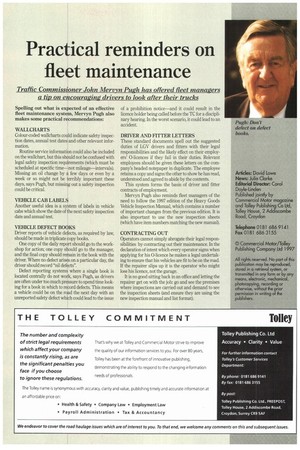Practical reminders on fleet maintenance
Page 42

If you've noticed an error in this article please click here to report it so we can fix it.
Traffic Commissioner John Mervyn Pugh has offered fleet managers a tip on encouraging drivers to look after their trucks
Spelling out what is expected of an effective fleet maintenance system, Mervyn Pugh also makes some practical recommendations: WALLCHARTS Colour-coded wallcharts could indicate safety inspection dates, annual test dates and other relevant information.
Routine service information could also be included on the wallchart, but this should not be confused with legal safety inspection requirements (which must be scheduled at specific time—not mileage—intervals). Missing an oil change by a few days or even by a week or so might not be terribly important these days, says Pugh, but missing out a safety inspection could be critical.
VEHICLE CAB LABELS Another useful idea is a system of labels in vehicle cabs which show the date of the next safety inspection date and annual test.
VEHICLE DEFECT BOOKS Driver reports of vehicle defects, as required by law, should be made in triplicate copy books.
One copy of the daily report should go to the workshop for action; one copy should go to the manager, and the final copy should remain in the book with the driver. Where no defect arises on a particular day, the driver should record `'nil defects".
Defect reporting systems where a single book is located centrally do not work, says Pugh, as drivers are often under too much pressure to spend time looking for a book in which to record defects. This means a vehicle could be on the road the next day with an unreported safety defect which could lead to the issue of a prohibition notice—and it could result in the licence holder being called before the IC for a disciplinary hearing. In the worst scenario, it could lead to an accident.
DRIVER AND FITTER LETTERS These standard documents spell out the suggested duties of WV drivers and fitters with their legal responsibilities and the likely effect on their employers' 0-licences if they fail in their duties. Relevant employees should be given these letters on the company's headed notepaper in duplicate. The employee retains a copy and signs the other to show he has read, understood and agreed to abide by the contents.
This system forms the basis of driver and fitter contracts of employment.
Mervyn Pugh also reminds fleet managers of the need to follow the 1997 edition of the Heavy Goods Vehicle Inspection Manual, which contains a number of important changes from the previous edition. It is also important to use the new inspection sheets (which have item numbers matching the new manual).
CONTRACTING OUT Operators cannot simply abrogate their legal responsibilities by contracting out their maintenance. In the declaration of intent which every operator signs when applying for his 0-licence he makes a legal undertaking to ensure that his vehicles are fit to be on the road. If the repairer slips up it is the operator who might lose his licence, not the garage..
It is no good sitting back in an office and letting the repairer get on with the job: go and see the premises where inspections are carried out and demand to see the inspection sheets (and ensure they are using the new inspection manual and list format).
































































































